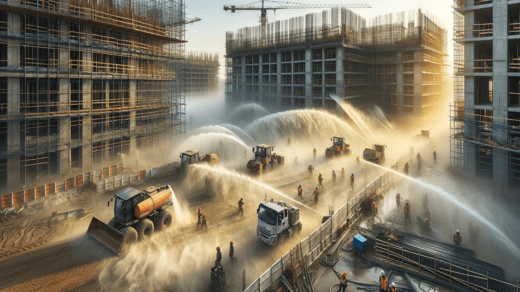Effective dust suppression on construction sites is crucial for ensuring the health and safety of workers, complying with regulations, and minimizing environmental impact. Dust control measures help prevent respiratory issues, visibility problems, and contamination of surrounding areas. This comprehensive guide provides detailed strategies and methods for dust suppression on construction sites.
Understanding the Sources of Dust
Dust on construction sites originates from various activities such as excavation, demolition, material handling, and vehicular movement. Identifying these sources is the first step in implementing effective dust control measures.
Health and Environmental Impacts
Health Risks
Construction dust poses significant health risks, including:
- Respiratory Issues: Inhalation of fine dust particles can cause respiratory diseases such as asthma, bronchitis, and silicosis.
- Skin and Eye Irritation: Dust particles can irritate the skin and eyes, leading to discomfort and potential injury.
- Long-term Health Effects: Prolonged exposure to construction dust can lead to chronic health conditions, including cancer.
Environmental Concerns
- Soil and Water Contamination: Dust particles can settle on soil and water bodies, leading to contamination and affecting local flora and fauna.
- Air Quality Degradation: Dust emissions contribute to air pollution, impacting the surrounding communities and ecosystems.
Regulatory Requirements
Compliance with regulatory standards is mandatory for construction projects. Regulations often require the implementation of dust control measures to limit airborne particulate matter.
- OSHA Standards: The Occupational Safety and Health Administration (OSHA) mandates permissible exposure limits (PEL) for dust and requires employers to implement control measures.
- EPA Guidelines: The Environmental Protection Agency (EPA) provides guidelines for minimizing dust emissions from construction activities.
Dust Suppression Techniques
Water-Based Solutions
Water Spraying
Water spraying is a widely used method for dust suppression. It involves spraying water on dust-prone areas to prevent dust particles from becoming airborne.
- Benefits: Simple, cost-effective, and easy to implement.
- Challenges: Frequent application required, potential water wastage.
Water Trucks and Cannons
Water trucks and cannons provide targeted dust suppression by spraying water over large areas. This method is suitable for large construction sites.
- Benefits: Effective for large areas, adjustable spray patterns.
- Challenges: High water usage, requires regular refilling.
Chemical Dust Suppressants
Chemical suppressants are used to bind dust particles and prevent them from becoming airborne. These chemicals are often mixed with water and sprayed on dust-prone areas.
- Benefits: Long-lasting effect, reduces water usage.
- Challenges: Potential environmental impact, cost of chemicals.
Mechanical Solutions
Road Sweeping
Regular road sweeping helps remove dust from construction site roads and pathways, reducing airborne dust.
- Benefits: Effective for large sites, improves site cleanliness.
- Challenges: Requires regular maintenance, equipment costs.
Gravel and Mulch Application
Applying gravel or mulch to exposed soil surfaces helps reduce dust generation by stabilizing the soil.
- Benefits: Cost-effective, reduces erosion.
- Challenges: May require frequent replenishment.
Vegetative Cover
Planting vegetation on exposed soil areas can significantly reduce dust generation. Vegetation acts as a natural barrier, trapping dust particles.
- Benefits: Environmentally friendly, improves site aesthetics.
- Challenges: Requires time to establish, maintenance needed.
Enclosures and Barriers
Constructing physical barriers such as fences, walls, and enclosures around dust-prone areas can effectively reduce dust dispersion.
- Benefits: Immediate dust reduction, protects surrounding areas.
- Challenges: Construction and maintenance costs, potential space limitations.
Monitoring and Maintenance
Dust Monitoring
Regular monitoring of dust levels is essential to ensure the effectiveness of dust suppression measures. Use dust monitoring equipment to measure particulate matter levels and adjust control measures as needed.
Maintenance of Dust Control Measures
Regular maintenance of dust control equipment and practices ensures their continued effectiveness. Schedule periodic inspections and repairs to maintain optimal performance.
Conclusion
Implementing effective dust suppression measures on construction sites is essential for protecting worker health, complying with regulations, and minimizing environmental impact. By understanding the sources of dust and employing a combination of water-based solutions, chemical suppressants, mechanical methods, vegetative cover, and physical barriers, construction sites can achieve significant dust reduction. Regular monitoring and maintenance of these measures ensure their continued effectiveness, contributing to a safer and more sustainable construction environment.



